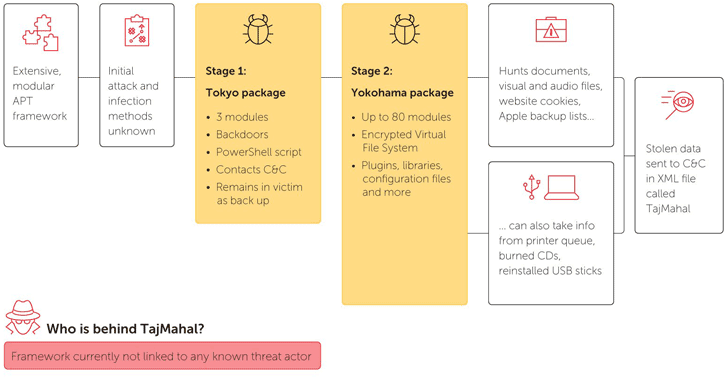a highly sophisticated spyware framework that has been in operation
for at least last 5 years—but remained undetected until recently.
Dubbed TajMahal by researchers at Kaspersky Lab, the APT
framework is a high-tech modular-based malware toolkit that not
only supports a vast number of malicious plugins for distinct
espionage operations, but also comprises never-before-seen and
obscure tricks.
By the way, Kaspersky didn’t mention why they named the
framework after Taj Mahal, one of the Seven Wonders of the World
located in India.
TajMahal toolkit was first discovered by
security researchers late last year when hackers used it to spy on
the computers of a diplomatic organization belonging to a Central
Asian country whose nationality and location have not been
disclosed.
[1]
However, malware samples examined by the researchers suggest the
cyberespionage group behind the attack has been active since at
least August 2014.
The TajMahal framework consists of two main packages—”Tokyo” and
“Yokohama”—that together contain over 80 distinct malicious
modules, which according to researchers, is one of the highest
numbers of plugins ever seen for an APT toolset.
“It includes backdoors, loaders, orchestrators, C2 communicators,
audio recorders, keyloggers, screen and webcam grabbers, documents
and cryptography key stealers, and even its own file indexer for
the victim’s machine,” the researchers say.
targets at the first place, but they do reveal that once accessed,
first stage infection Tokyo is downloaded on targeted
machines, which then deliver the fully-functional second-stage
malware Yokohama.
File System which allows the malware to:
- log keystrokes,
- steal browser cookies and data, including backup for Apple
mobile devices, - record and take screenshots of VoIP calls,
- steal written CD images,
- steal documents sent to the printer queue.
Besides usual spying capabilities, the malware also includes some
more unique features like requesting to steal a particular file
from a previously plugged in USB stick. So, next time when the USB
is connected to the infected computer, the file will be stolen.
Though the researchers found only one TajMahal victim so far but
given the framework’s sophistication, they believe there are other
victims that have yet to be discovered.
“So far we have detected a single victim based on our telemetry,”
Kaspersky said.
“This theory is reinforced by the fact that we couldn’t see how
one of the files in the VFS was used by the malware, opening the
door to the possibility of additional versions of the malware that
have yet to be detected.”
blog[2], where the researchers
have also published a full set of Indicators of compromise (IOCs)
and a complete list of 80 malicious modules stored in the malware
with a short description describing what they do.
References
- ^
discovered
(www.kaspersky.com) - ^
SecureList blog
(securelist.com)
Read more http://feedproxy.google.com/~r/TheHackersNews/~3/t4K6SqP9PfU/apt-malware-framework.html

